It is no secret that Angelfish are one of the most popular fish to occupy home aquariums.
People love them for numerous reasons, with the more common being their unusual yet amazing body shapes, paired with equally unique coloring, and abundance of different species.
Angelfish also go by the name of Pterophyllum, which is the scientific name gifted to them. For many tank owners, or aspiring hobbyists, a commonly posed question is “what can go with Angelfish”.
We all know they are an extremely sought-after fish for those looking to build peaceful and beautiful underwater communities, however, they do have certain tendencies that may clash with other types of fish and marine life.
It is important to have the right knowledge when it comes to building a peaceful tank with glorious fish that can all live happily together in harmony.
If not, you can end up creating a disruptive environment which will often lead to unnecessary injuries, and even fatalities, and you do not want that!
On the other hand, however, you can build up an incredible aquarium, filled with fish that co-exist together without any issues.
The main goal of this article is to not only provide information on fish that get along well with Angelfish, but to highlight the most colorful ones that complement Angelfish, making for a peaceful and brightly colored environment.
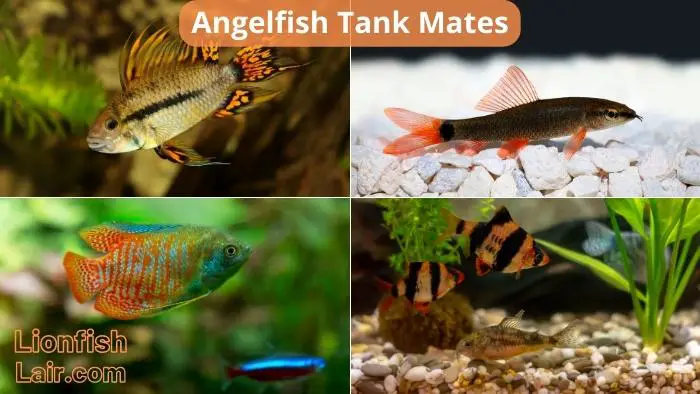
Angelfish Tank Mates
So, what can you mix with Angelfish? To many people’s surprise, there are actually many different fish that can live with Pterophyllum (Angelfish) in total peace, while also possessing some awesome coloration.
Most of the fish you will see on the list are readily available in most fish stores as well. Whatever stage you are at with your fishkeeping and aquarium journey, most of these suggestions will be perfect for you, and most importantly, for your Angelfish!
Many different factors determine whether specific types of fish get along, and while “on paper” some fish do and should live in peace with one another, it doesn’t always work out like that.
This list is based on the opinions and experience of experts, but every now and then an anomaly can occur and a fish on this list may not get along with your angelfish. Tank setup, size, décor, and the age and size of the fish inhabiting your tank will all play factors in this.
However, this list is incredibly varied and has been curated with the most Angelfish friendly fish that are out there currently, in addition to the ones who possess the most color.
As a rule of thumb, whenever purchasing new fish, you should always try and buy fish the same as, or at least close to the size of your own. With some potentially requiring a habitat move when growing into an adult.
List of Colorful Fish Compatible with Angelfish
So, here are the most compatible, and beautiful angelfish tank mates available for freshwater aquariums.
I have provided a description of each with a graphic summarizing the fish and their specific requirements:
Dwarf Cichlids
There are many different fish that share the Dwarf Cichlid family, so it may be difficult to choose the right one for your tank.
More specifically, Kribensis Cichlid’s are extremely colorful and are easy to take care of, they display an incredible array of pink, green, yellow, red and more colors, with additional spotty patterns too.
Some have been known for having territorial and aggressive tendencies, so be careful. It might be better to try out some other colorful Dwarf Cichlid’s first.
Much like the Electric Blue Ram, the Double Red Agassizi is a beautiful little fish, vibrant in color, and hails from South America, and more specifically the Amazon Basin of South America.
Growing up to 4 inches (10 cm) in length, the fish is tank-raised and has been bred specifically for its incredibly unique and beautiful coloration within the dorsal and caudal fins.
The best combination is having 1 male to 3 or 4 females, this group tends to be well-tempered and a pretty relaxed fish.
Ram Cichlids, and more specifically the Mikrogeophagus ramirezi can be found in both Venezuela and Colombia, like their Electric Blue counterparts.
They grow up to 3 inches (7.5 cm) in length and are, for the most part, a model citizen of any aquarium, and the perfect tank mate for an Angelfish.
These vibrant little fish come in many different color variations, with one of the more favorable and popular being the Golden Ram, or the Electric Blue Ram. It is better for them to be kept in groups or opposite sex pairs.
Below is a graphic summarizing dwarf cichlids and their requirements:
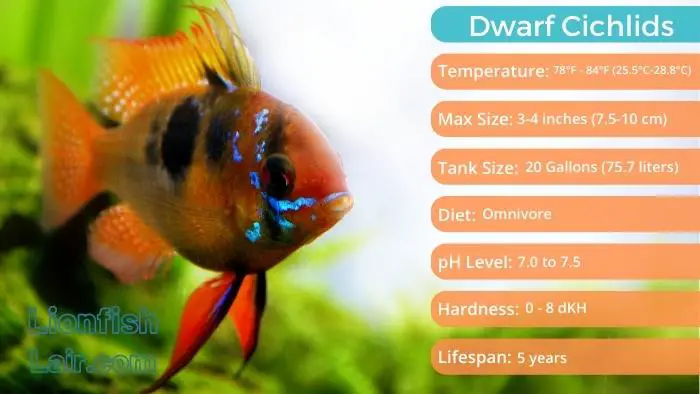
Tropical Sharks
When choosing sharks as additions to an aquarium, not just company for your Angelfish, it is vastly important to have the right sized tank, a good length aquarium that contains lots of hiding spaces for them.
The Rainbow Shark is quite the specimen, with a beautiful green/brown body, and bright orange fins, it really is a must-have shark for your aquarium. Rainbow Sharks can grow to a maximum of 6 inches (15 cm) in length.
If your aquarium meets the right requirements, you should choose sharks similar in length to your existing fish and their potential tank mates.
Sharks’ behavior varies from time to time, and they can act erratic sometimes, which may unnerve and stress out Angelfish, that is why it is a good idea to have some areas in your tank where your Angelfish can relax away from the rest of the aquarium.
The Albino Shark is essentially the Rainbow Shark but with Albino characteristics. A pinky white body, paired with bright red fins and eyes.
Much like the Rainbow Shark, these will grow to around 6 inches (15 cm) in length, and it is important to have a suitable tank with hiding spaces for this fish. Below is a tropical shark overview:
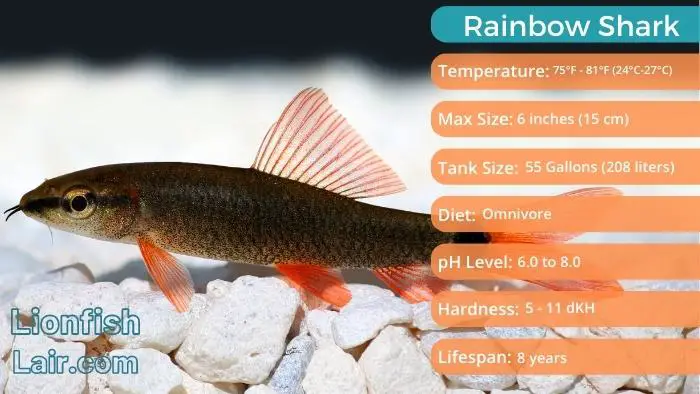
Barbs
The Barb fish are one of the various ray-finned species. When you are selecting the right one for your aquarium, make sure to ask your fish store which ones are the more chilled out species to buy.
Even the smaller Barbs can be incredibly aggressive and horrible. For example, Tiger Barbs are well-known fin nippers, and will likely try and bully and abuse your Angelfish, so refrain from them!
The Tinfoil Barb is well natured, however, they can grow to a whopping 18 inches (45 cm) long and operate best in groups of 5 or more, so you will need a suitable tank to accommodate the adults.
The Odessa Barb, despite looking rather menacing with their black gray bodies, mixed in with a blood red are some of the best natured Barbs and would most definitely be a suitable tank mate for the Angelfish.
It is advised to buy a mixture of sexes and around 10 fish. They also only grow to around 3 inches (7.5 cm), so are certainly some of the more manageable fish from this species.
The below graphic contains everything you need to know about barb fish:
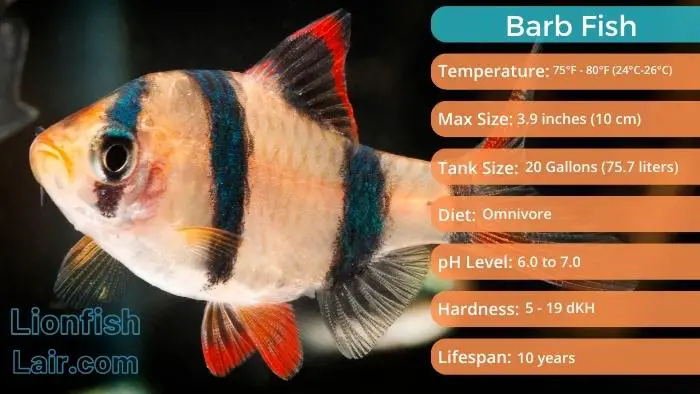
Gourami
The Gourami are an extremely hobbyist friendly fish, they share similar requirements to the Angelfish to start with, which is ideal when purchasing them to accompany your Angels, they share similar sizes and tendencies, making caring for these fish much the same as an Angelfish.
This saves a lot of time and stress since you don’t need to keep thinking about the different tendencies and caring procedures for each type of fish.
The Snakeskin Gourami is a great example of a well-mannered, and easy to look after tank mate for the Angelfish.
The coloration and texture resemble snakeskin, hence the name, with some nice green, blue, and brown colors seeping across their bodies.
The Snakeskin Gourami can grow to 10 inches (25 cm) in length and reach sexual maturity at around 3-4 inches (10 cm). Another redeeming quality they possess is that they do not eat even the tiniest of other fish, they are peaceful and calm.
Their smaller counterparts are the Dwarf Gourami, who have gorgeous blue shiny bodies, with bright orange stripes vertically running along them.
The best environment for the dwarfs is a tank with plenty of light exposure (which also adds to the glistening shiny scales), lots of algae, and a lot of plants and greenery. These Gourami only grow to 2 inches (5 cm) in length too, meaning they won’t require too much space.
Here you have a graphical overview of the dwarf gourami:
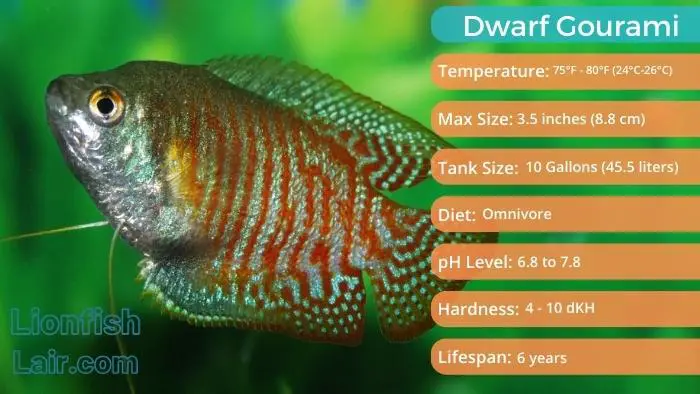
Conclusion
In summary, Angelfish are not exactly small fish, growing up to almost 7 inches (17 cm) in length, and can be slightly aggressive when they want to be, that is why careful consideration has been used when curating this list.
Not only has this list got some of the most colorful fish that can live with Angelfish, but also some of the most passive fish to cohabitate with them.
It is crucial that you know the species you are going to buy as a potential Angelfish tank mate because most will be “growers” and end up bigger than they are when you buy them.
This means that you should have a suitable aquarium to house not only the Angelfish, but the other fish to accompany them.

